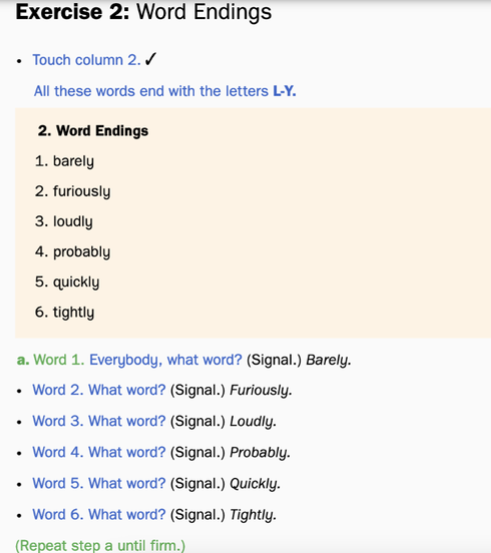Teach Reading Mastery Transformations Years 4 and 5
-
Module Introduction5 Topics
-
Overview13 Topics|2 Tests
-
Cover
-
Lesson Objective
-
Opening the Lesson
-
Direct Instruction Overview
-
Core Features of RMT 4-5
-
Video: RMT 4-5 Videos on Informational and Narrative Text
-
Who the Program is Intended for and Time Requirements
-
RMT 4-5 Teacher and Student Materials
-
Check Your Understanding
-
Teacher’s Guide
-
Test Your Understanding
-
Review
-
Lesson Completed
-
Cover
-
Setting up for Success24 Topics|3 Tests
-
Cover
-
Lesson Objective
-
Opening the Lesson
-
Placement Test Overview
-
Placement Test Guidelines
-
Placement Test Directions
-
Placement Test
-
Grouping and Classroom Arrangement
-
Check Your Understanding
-
Using a Script
-
Group Displays
-
Online Teacher’s Course
-
Signals
-
Signal Specifics
-
Video: Auditory Signal
-
Pacing
-
Check Your Understanding
-
Teaching to Mastery
-
Error Correction Procedures
-
RMT 4 Lesson 2, Exercise 3 Correction Procedure
-
Error Correction Practise
-
Test Your Understanding
-
Review
-
Lesson Completed!
-
Cover
-
Word Practice and Vocabulary Definitions18 Topics|4 Tests
-
Cover
-
Lesson Objective
-
Opening the Lesson
-
Word Practice
-
Individual Turns
-
Teaching Word Practice and Individual Turns
-
Check Your Understanding
-
Vocabulary Words
-
Video: Vocabulary
-
Teaching Vocabulary
-
Check Your Understanding
-
Word Practice Correction Procedures
-
Vocabulary Correction Procedures
-
Video
-
Check Your Understanding
-
Test Your Understanding
-
Review
-
Lesson Completed!
-
Cover
-
Story Selections and Comprehension17 Topics|4 Tests
-
Cover
-
Lesson Objective
-
Opening the Lesson
-
Group Oral Reading
-
Presenting Oral Reading Exercises
-
Check Your Understanding
-
Story Reading Correction Procedures
-
Story Reading Correction
-
Silent Reading
-
Check Your Understanding
-
Presenting Comprehension Questions
-
Comprehension Questions
-
Comprehension Correction Procedures
-
Check Your Understanding
-
Test Your Understanding
-
Review
-
Lesson Completed!
-
Cover
-
Writing Assignments, Paired Practice and Fact Games17 Topics|3 Tests
-
Cover
-
Lesson Objective
-
Opening the Lesson
-
Writing Assignments
-
Writing Assignments (Continued)
-
Writing Assignment Teaching Suggestions
-
Video: Writing Assignment
-
Check Your Understanding
-
Paired Practice
-
Paired Practice Teaching Suggestions
-
Implementing Paired Practice
-
Decoding Support
-
Check Your Understanding
-
Fact Games
-
Test Your Understanding
-
Review
-
Lesson Completed!
-
Cover
-
Independent Work and Work Check16 Topics|3 Tests
-
Cover
-
Lesson Objective
-
Opening the Lesson
-
Independent Work Overview
-
Independent Work Procedures
-
Teaching Suggestions for Independent Work
-
Check Your Understanding
-
Group Work Check
-
Group Work Check Procedures
-
Group Work Check
-
Check Your Understanding
-
Active Monitoring
-
Active Monitoring
-
Test Your Understanding
-
Review
-
Lesson Completed!
-
Cover
-
Mastery Tests and Fluency Checkouts20 Topics|3 Tests
-
Cover
-
Lesson Objective
-
Opening the Lesson
-
Mastery Tests Overview
-
Independent Work Components
-
Online Components for Administering Mastery Tests
-
Mastery Test: Creating an Assignment
-
Check Your Understanding
-
Mastery Test: Student Experience
-
Video: Mastery Test: Student Experience
-
Fluency Checkout Overview
-
Online Components for Fluency Checkouts
-
Video: Fluency Checkouts Video Using Online Tools
-
Completing Fluency Checkouts
-
Teaching Suggestions and Identifying Errors During Checkouts
-
Check Your Understanding
-
Video: A Teacher Administering a Fluency Checkout
-
Test Your Understanding
-
Review
-
Lesson Completed!
-
Cover
-
Remedy Lessons and Retesting16 Topics|3 Tests
-
Cover
-
Lesson Objective
-
Opening the Lesson
-
Passing Criteria for Fluency Checkouts
-
Passing Criteria for Mastery Tests
-
Check Your Understanding
-
Recording Mastery Test and Checkout Scores
-
Video: Remedy Lesson
-
Firming Students and Delayed Tests
-
Good-bye List
-
Video: Implementing a Good-bye List
-
Check Your Understanding
-
Reviewing Mastery Test and Checkout Data
-
Test Your Understanding
-
Review
-
Lesson Completed
-
Cover
-
Setting Expectations and Motivating Students25 Topics|3 Tests
-
Cover
-
Lesson Objective
-
Opening the Lesson
-
Setting Expectations and Motivating Students: Overview
-
Video: Teaching Rules and Routines
-
Providing Specific Praise
-
Motivating Students and Affirmations
-
Video: Teacher Using Affirmations
-
Check Your Understanding
-
Routines and Expectations
-
STAR Rules
-
Video: Teaching Routines
-
Implementing the Teacher-Student Game
-
Teacher-student Game Scenario
-
Celebrations and Rewards for Students
-
Video: Teacher-Student Game
-
Check Your Understanding
-
Transitions
-
Video: Transitions
-
Being Prepared
-
Pacing of the Lesson
-
Video: Responses Per Minute
-
Test Your Understanding
-
Review
-
Lesson Completed
-
Cover
-
Goal Setting and Tracking Student Progress18 Topics|3 Tests
-
Cover
-
Lesson Objective
-
Opening the Lesson
-
Goal Setting Overview
-
Story Reading Goals
-
Mastery Goals
-
Tracking Mastery During Lessons
-
Tracking Mastery Scenario
-
Video: Data Collection
-
Check Your Understanding
-
Lesson Progress Goals
-
Data Wall
-
Video: What is a Data Wall?
-
Check Your Understanding
-
Video: Tracking Progress Using a Data Wall
-
Test Your Understanding
-
Review
-
Lesson Completed
-
Cover
-
Teaching a Lesson from RMT 416 Topics
-
Cover
-
Lesson Objective
-
Opening the Lesson
-
Lesson 36, Exercise 1: Word Practise
-
Lesson 36, Exercise 2: Vocabulary Review
-
Lesson 36, Exercise 3: Vocabulary Words
-
Lesson 36, Exercise 4: Individual Turns
-
RMT 4 Lesson 36, Exercises 1-4
-
Correcting Errors
-
Lesson 36, Exercises 1-4 with Correcting Errors
-
Lesson 36, Exercise 5: Vocabulary Definitions
-
Lesson 36, Exercise 6: Hyphens
-
Lesson 36, Exercises 5 and 6 and Specific Praise
-
Lesson 35, Exercise 7: Reading Literature: Fable
-
Error Limit
-
Work Assignment and Word Check
-
Cover
-
Teaching a lesson from RMT 518 Topics|1 Test
-
Cover
-
Lesson Objective
-
Opening the Lesson
-
Lesson 4, Exercise 1: Compound Words
-
Lesson 4, Exercise 2: Names
-
Lesson 4, Exercise 3: Vocabulary Words
-
Exercise 4: Vocabulary Review
-
Lesson 4, Exercise 5: Individual Turns
-
RMT 5 Lesson 4, Exercises 1-5
-
Lesson 4, Exercise 6: Vocabulary Definitions
-
Lesson 4, Exercise 7: Deductions
-
Correcting Errors
-
Lesson 4, Exercises 6-7 with Correcting Errors
-
Lesson 4, Exercise 8, Reading Literature: Epic
-
Decoding Error Limit
-
Epic Reading, Picture Comprehension and Correcting eErors
-
Review
-
Lesson Completed
-
Cover
-
Module Evaluation Survey1 Topic
Participants 482

Signal Specifics
There are five steps to follow when using each type of signal:
Focus – Check that students are following the direction given by the teacher. Example: “Touch word one” or “Eyes on me”
Think time – Pause for about two to three seconds to allow students time to process the answer.
Cue – Provide a cue to let students know the signal is coming. Example: “What word” – This will often be indicated in the script.
Interval – Pause for one second before giving a signal.
Signal – Use either an auditory or visual signal so that students answer in unison. If students are looking at their book or worksheet, the teacher will use a snap, clap, or tap. If students are looking at the teacher, the teacher will use a hand drop signal. Take a minute to practice presenting exercise 2 from RMT 4, lesson 4. In this exercise, students are looking at their book, so an auditory signal is used.


